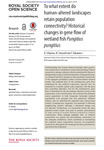Please use this identifier to cite or link to this item:
http://lib.hpu.edu.vn/handle/123456789/23661| Title: | To what extent do human-altered landscapes retain population connectivity? |
| Authors: | Ishiyama, N. Sueyoshi, M. Nakamura, F. |
| Keywords: | Biology Ecology Genetics |
| Issue Date: | 2015 |
| Abstract: | Understanding how human-altered landscapes affect popula-tion connectivity is valuable for conservation planning. Natural connectivity among wetlands, which is maintained by floods, is disappearing owing to farmland expansion. Using genetic data, we assessed historical changes in the population connectivity of the ninespine stickleback within a human-altered wetland system. We predicted that: (i) the contemporary gene flow maintained by the artificial watercourse network may be restricted to a smaller spatial scale compared with the gene flow preceding alteration, and (ii) the contemporary gene flow is dominated by the downstream direction owing to the construction of low-head barriers. |
| URI: | https://lib.hpu.edu.vn/handle/123456789/23661 |
| Appears in Collections: | Education |
Files in This Item:
| File | Description | Size | Format | |
|---|---|---|---|---|
| 0419_Towhatextentdohuman.pdf Restricted Access | 744.79 kB | Adobe PDF |  View/Open Request a copy |
Items in DSpace are protected by copyright, with all rights reserved, unless otherwise indicated.
